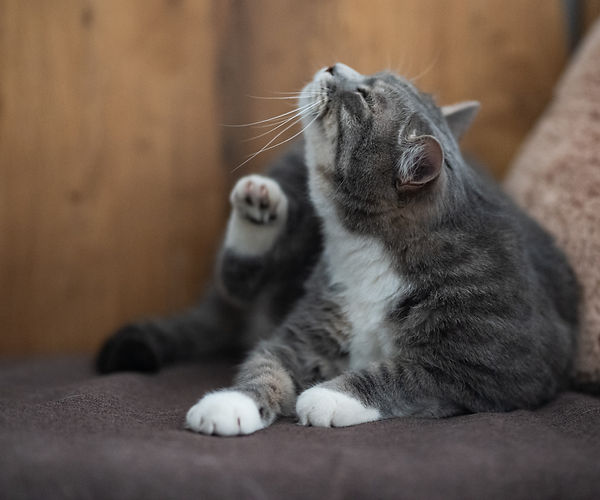
Cats are affectionate creatures (albeit on their own terms) and when Fluffy demands that scratch under her chin or a stroke down her back, you may come across a lump, bump, or even some crusts. The fastidious nature of cats means that what you’ve found isn’t likely to be foreign material stuck in her fur, but actually some changes within the skin itself. MiDOG Next-Gen Sequencing Technology may be appropriate in assisting with a diagnosis, but first, let’s discuss the types of skin lesions you may find.
Identifying the Cat’s Skin Bump
First off, “bumps” on Kitty’s skin can be divided into three categories: swellings, masses, and crusts. Identifying which category Kitty’s lesions fall into will lead your veterinarian to what is called a differential diagnosis. This is a list of the potential underlying causes for the changes you’re witnessing in your furry friend’s skin. For example, the list below shows the most common causes for each “bump” type:
Swellings (pockets of material under the skin):
- Abscess (pus)
- Seroma (serum)
- Hematoma (blood)
Masses (nodular lesions):
- Neoplasia – malignant (cancerous) vs benign (non-cancerous)
- Cyst (glandular material)
- Granulomatous lesion (chronic inflammation)
- Papilloma (wart)
Crusts (scabs):
- Dermatitis – usually associated with allergies to fleas, the environment, or food
- Pyoderma (bacterial skin infection)
- Sarcoptic mange (scabies)
- Ear mites
- Ringworm (fungal infection)
When Should You Be Concerned?
Any changes in your cat’s skin warrants a trip to the veterinarian, but only a sick cat who is lethargic, painful, inappetent, or feverish makes it an emergency visit. Otherwise, the next available appointment should suffice. Be prepared to advise your veterinarian whether Kitty is biting, scratching, or over grooming. Let the doctor know if you’ve seen any changes to the lesion(s) since you first noticed it and whether Kitty herself notices it at all, too. Prompt attention by your veterinarian is warranted if Kitty is exhibiting any of the following symptoms:
- A nodule that has increased visibly in size within the span of 3 months
- Any nodule >/= 1cm
- Scratching or biting herself (if intense enough to cause bleeding, this graduates to urgent care / emergency)
- Head shaking
- Inflammation
- Alopecia (fur loss, balding)
- A fluctuant swelling with or without discomfort
- Scabs and crusts

Close-up of cat infected with ringworm
Obtaining A Diagnosis
Fluffy’s history and physical examination will narrow down the possibilities significantly. For example, if Fluffy is a kitten with crusts recently adopted from a rescue group or shelter, it will dictate that an infectious or parasitic cause is at the top of the list. Ringworm, ear mites, and mange spread easily with close contact and kittens are often housed in groups. Or if Kitty is an outdoor cat with a fever and lethargy, an abscess will be the number one rule out for a swelling. Cats frequently fight amongst themselves when adventuring outdoors and this pocket of infection often occurs after a puncture wound from a claw or tooth.
At times, differentiating between an abscess, seroma, or cyst can be challenging. Swellings are typically aspirated by your veterinarian with a needle and syringe to visualize the type of fluid present. If the appearance is atypical or Fluffy’s history is vague, the color and consistency of the fluid may not be enough to establish a diagnosis. Along with fluid analysis sent to the lab, diagnostic testing such as MiDOG Next-Gen Sequencing (NGS) Technology is useful in determining whether a bacterial component is or is not present in fluid sampled from this type of lesion. Identifying a bacterial presence will result in the appropriate antibiotic use to clear the infection as quickly as possible.
Furry friends with crusts will often have a test performed called a skin scrape. Crusts are scraped off and viewed under a microscope to identify if mites are present. A similar test is done with ear debri if an ear infection is present. Crusts, flakes, and alopecia also warrant evaluating the lesions with an ultraviolet light looking for evidence of ringworm. This test is only accurate for 50% of these fungal cases, however, so is not appropriate as a stand alone test if negative. NGS Technology is capable of differentiating between fungal and bacterial infections in a single stand alone test and is a useful tool in guiding your veterinarian to their diagnosis. This is superior to the “gold standard” culture and sensitivity test that focuses primarily on identifying bacteria alone.
In addition to sampling a swelling with a needle and syringe, a similar technique can be used for nodules to obtain cells for cytology. Cells are smeared onto a slide and evaluated under a microscope in the hopes of identifying the type of lesion. If warranted by the behavior or size of the mass, surgical removal and biopsy may also be necessary.
Treatment For Your Cat’s Skin Bump
The long list of changes that are possible in your fur baby’s skin makes the treatment list just as variable. Your veterinarian will advise you on the appropriate treatment course, but the below list will prepare you for what you can possibly expect:
- Small nodules, cysts, hematomas, or papillomas = watchful waiting
- Larger or fast growing nodules = cytology or surgical removal / biopsy
- Seroma = surgical correction to decrease the size of the subcutaneous space (under the skin)
- Abscess = antibiotics +/- surgery
- Environmental allergies = steroids
- Food allergy (suspected) = hypoallergenic feeding trial x 8-10 weeks
- Granuloma = combination of steroids and antibiotics
- Pyoderma = antibiotics
- Ringworm = antifungal products
- Mites = anti-parasiticides
As you can see, there are many possibilities for changes in a cat’s skin and paying close attention to your kitty’s demeanor, activities, and physical well being will allow you to identify them early on. Simply snuggling and petting your furry friend can be part of examining her for any changes that may alert you to a problem. And, of course, she will likely enjoy the experience and demand it anyway. She is, after all, a cat.
The MiDOG All-in-One Microbial Test utilizes NGS technology to detect and quantify microbial DNA through untargeted and comprehensive sequencing and quantitative comparisons to reference databases. The MiDOG NGS technology provides a useful opportunity to shed light on the microbial makeup of your cat’s skin for clinical application. The MiDOG microbial test is grounded on scientific research that provides veterinarians DNA evidence for the guided treatment of feline skin infections. A MiDOG microbial test provides the technologies for the accurate identification of all microorganisms within a pet’s sample, independent of culturing.
Find out if your vet uses MiDOG before you book your next appointment!
Categories: Cats, Next-Gen DNA Sequencing Technology, Skin Health, Veterinary Dermatology

